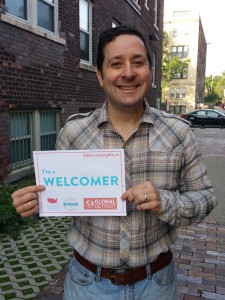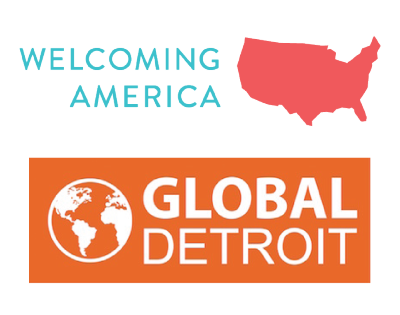Local and Federal Efforts to Promote Citizenship Surge
/in All Blogs /by gglnadminThe White House capped the fourth annual Welcoming Week and last Thursday’s Constitution/Citizenship Day commemorations by unveiling it’s “Stand Stronger” public awareness campaign based on key recommendations from the White House Task Force for New Americans. The announcement included several programs and initiatives that to promote the rights, responsibilities, and opportunities of citizenship among eligible legal permanent residents (LPRs), and break down the barriers that LPRs face in naturalizing, as well as the announcement of the Building Welcoming Communities Campaign.
President Obama has had a clear and consistent message on immigration, noting that we are a nation of immigrants, that immigrants strengthen our economy, and that immigrants add to the rich fabric of our society. As part of his executive actions, President Obama established a White House Task Force for New Americans, a government-wide effort tasked with enhancing the integration of immigrants and refugees into our communities. The Task Force reminds us that, “This isn’t just a priority because it’s the right thing to do. It’s also vital to our economic future.”
Nearly 9 million people live, work, and pay taxes in this country as LPRs and are eligible for citizenship, yet only about eight percent of them naturalize each year. Nearly one third (29.5%) have been in the U.S. for more than twenty-five years, contributing to our communities for decades. These efforts of the federal government point to more robust national vision towards a smoother pathway for New Americans. The Stand Stronger campaign acknowledges:
- Cities that are working to expand naturalization outreach and processing programs;
- Presidential Ambassadors for Citizenship and Naturalization;
- Grants supporting citizenship and refugee integration;
- A Welcoming Communities Americorps program;
- Increased access to low-cost legal services for immigrants and refugees; and
- The Building Welcoming Communities campaign
The announcement of the Building Welcoming Communities Campaign, the White House’s partnership with Welcoming America to encourage local communities to engage in local immigrant integration efforts, calls on local communities to act on a set of principles to build inclusive and welcoming communities that allow immigrants to thrive and succeed enhancing the communities at large.
Forty (40) major U.S. cities and counties we announced as part of yesterday’s Building Welcoming Communities campaign launch, from Pittsburgh to St. Louis, Buffalo to Detroit, Philadelphia to Columbus. Sixeen (16) out of those 40 – 40 percent – are in our WE Global Network 10-state region and the vast majority of these regions have active WE Global Network member organizations. The number of Rust Belt cities embracing immigrants as a means of revitalizing urban neighborhoods and spurring local economic growth continues to grow, positioning the Network at the leading edge of the growing movement. As a more welcoming approach to immigration spreads quickly across the Rust Belt – and pays off for local economies – this new field of practice is picking up steam.
Such efforts have been shown to have a significant impact on local economies. For example, in Dayton, the Welcome Dayton initiative has been credited with expanding opportunities for an increasingly diverse community, reversing population decline, and boosting economic competitiveness and vitality.
While the benefits of naturalization for immigrants are clear (studies show that naturalized immigrants earn 8-11% more after naturalization, and family incomes rise an average of 15%), the conversation surrounding the value add to our communities and country is less prevalent. Naturalized citizens stay in the U.S. longer, have better English language abilities, and have more education. These factors contribute to a higher likelihood of investments in U.S.-specific skills, and better job matching to a wider range of jobs. Naturalized citizens have lower unemployment rates, are half as likely to live below the poverty line, and weathered the recent economic crisis more successfully than noncitizens.
In Midwestern metros, immigrants account for 38.4% of population growth, indicating immigration and population growth go hand in hand. Over the next 20 years, immigrants and their children will account for 85% of the net growth in the U.S. labor force. Immigrants are entrepreneurial, starting 28% of all new businesses. Moreover, a study by the Partnership for a New American Economy found that immigrants or their children have founded 45% of Fortune 500 companies in the Rust Belt.
WE Global supports increased citizenship for immigrants as an economic development strategy, and the efforts of the White House will provide a huge boost to the local initiatives in our Rust Belt cities. If the 8.8 million LPRs in the U.S. became citizens, it could bolster the economy with ripple effects for generations forward – naturalized citizens put money back into the economy, provide strength to communities, and make our regional economy more productive.
Welcoming Week: A Reflection on America’s “Golden Door”
/in All Blogs, Welcoming Week, Refugee Resettlement /by gglnadmin
Steve Tobocman is a Welcomer! Snap a photo with the I Am a Welcomer sign and post it to social media with the hashtags #AmericaWelcomes and #WelcomingWeek. Click Steve’s photo to get the sign and find other ways to take action.
As the grandson of Jewish grandparents who fled Poland in the early 20th Century only to have all of their remaining family perish in the Holocaust, I grew up with a strong belief in the United State as the world’s haven for those fleeing persecution, oppression, and tyranny. I remember learning the powerful words of Emma Lazarus that are inscribed on the pedestal of the Statue of Liberty during my temple’s Sunday School classes:
From her beacon-hand glows world-wide welcome . . . ‘Give me your tired, your poor, your huddled masses yearning to breathe free, the wretched refuse of your teeming shore. Send these, the homeless, tempest-tost to me, I lift my lamp beside the golden door!’
The gripping pictures of a lifeless Syrian boy—approximately the same age and dress as my own two-year-old son Adiv—on a Turkish shore last week is enough to shock even the busiest American parent. Considering that the UN High Commission on Refugees has now registered over 4 million Syrian refugees and some 2,500 refugees have perished at sea trying to escape the conflict, the humanitarian issues facing the current crisis are truly catastrophic.
This week marks the fourth annual National Welcoming Week, during which communities all across America will celebrate the nation’s welcoming nature and the contributions that immigrants and refugees have made to our communities. The week’s events bring immigrants and refugees together with their neighbors in a spirit of unity.
Given the gripping headlines about the Syrian refugee crisis, this year’s Welcoming Week should provide ample opportunity for Americans to reflect on how our region could play a pivotal role in responding to the crisis and how our response would impact our local communities. This past May, the New York Times ran an editorial entitled “Let Syrians Settle Detroit,” noting that Metro Detroit’s “vibrant and successful” Arab-American community could help make our region more welcoming than others for resettling Syrians. Specifically, the editorial commented that, “From its original Native Americans to the Great Migration of Southern blacks to the infusion of Hispanic and Arab immigrants, Detroit has been a melting pot of religions, ethnicities and cultures.” Welcoming can be the difference maker in successful refugee resettlement and integration.
The reality is that refugee resettlement in communities across the nation would provide specific and tangible economic benefits to the local communities that serve as the new home for suffering families. A recent economic impact study on refugee resettlement efforts in Greater Cleveland concluded that the resettlement of some 4,500 refugees from 2000-2012 in the Cleveland metro area created $48 million in economic activity and 650 jobs in 2012 alone.
German Chancellor Angela Merkel has grabbed international headlines and praise for her leadership in pledging to accept as many as 800,000 Syrian refugees in the coming year. In addition to the deep humanitarian significance for Germany to define itself as a safe harbor for refugees, observers have been quick and correct to point out that her actions are motivated also by economic self-interest. With declining birth rates and a rapidly-aging workforce—conditions that plague Detroit, Cleveland, the Midwest, and many American communities—Syrian refugees represent an opportunity to inject new labor and energy into Germany’s economy. Merkel is planning for Germany’s long-term economic prosperity.
Midwesterners and Americans need to look no farther than the Minneapolis/St. Paul region to realize that serving as a hub for refugee resettlement can strengthen our economy and secure our long-term prosperity. Home to tens of thousands of Hmong, Somali, Vietnamese and other ethnic residents—most of whom can trace refugee resettlement histories as part of their community’s migration story—the Twin Cities possesses one of the fastest-growing economies and highest per capita incomes in the Midwest.
No doubt there are complex geo-political issues that need to be carefully considered in resolving the Syrian, other Middle Eastern, and African refugee crises, but one aspect that should not be in dispute is the local economic benefits to economies like Metro Detroit, Cleveland, Minneapolis/St. Paul, and Germany. Refugees bring new energy, resourcefulness, and an eagerness to pursue freedom and opportunity. It’s the same recipe that brought my grandparents to Detroit and millions of others’ families to America.
This Welcoming Week let us celebrate those contributions and resolve to welcome the world’s newest “tempest-tost.”

